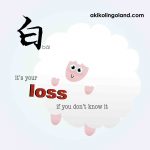Mandarin Thru Singlish (1) – why like that one!
If you’re living in Singapore, or if you’ve travelled to Singapore before, you must have been puzzled/ annoyed/ amused (or all of the above) by the Singlish used here.

Regardless of your attitude toward Singlish, if you know Mandarin, Singlish would definitely make more sense to you. And, not surprisingly, knowing Singlish would also make understanding and learning Mandarin a little more interesting. This is not to say that Singlish comes from Mandarin, but that the Chinese language plays a huge part in shaping Singlish.1 Let’s try to decode some Singlish features and reveal the underlying Chinese roots!
There is one word that one often hears in Singlish – ‘one’. This is one guy that unabashedly allows himself to stand out at the end of sentences.
1. Nice? I made one.
2. Wah so clean. You clean one ah?
3. Who say one?
4. He won’t mind one.
5. She won’t like one.
6. He very kiasu one.
7. Why you like that one?
8. Like that very ugly one.
So, why do we have this ‘one’ at the end of sentences? You’d have noticed that I have written the example sentences in two different colours. That’s because we are looking at two different ‘one’s that express different things. Well, to start understanding this, one needs to first look at one particular use of ‘one’ in English.
a. Give me the red one.
b. This shirt is too small. Get a bigger one.
c. Can I have the sweeter one?
‘One’ in these sentences is used to refer to something that has already been mentioned or is known about. To be specific:
a. Give me the red one. (Give me the red pen/ shirt/ apple.)
b. This shirt is too small. Get a bigger one. (Get a bigger shirt.)
c. Can I have the sweeter one? (Can I have the sweeter apple/ orange?)
In Mandarin, we use 的 ‘de’ for this function of ‘one’. Let’s see how the above English sentences would look like in Mandarin.
a. Give me the red one. (Give me the red pen/ shirt/ apple.)
Gěi wǒ hóngsè de. (Gěi wǒ hóngsè de bǐ/ chènshān/ píngguǒ.)
给我红色的。(给我红色的笔/ 衬衫/ 苹果。)
b. This shirt is too small. Get a bigger one. (Get a bigger shirt.)
Zhè jiàn chènshān tài xiǎo, ná dà yìdiǎn de. (Ná dà yìdiǎn de chènshān.)
这件衬衫太小,拿大一点的。(拿大一点的衬衫。)
c. Can I have the sweeter one? (Can I have the sweeter apple/ orange?)
Gěi wǒ tián de, xíng ma? (Gěi wǒ tián de píngguǒ/ júzi)
给我甜的,行吗?(给我甜的苹果/ 橘子。)
Now that we have seen that 的 ‘de’ is associated with ‘one’ in English, let’s take a look at how it fits into the Singlish examples I gave above, and how they are expressed in English.
1. Nice? I made one.
Hǎokàn ma? Wǒ zuò de.
好看吗?我做的。
English: Nice? I made it.
2. Wah so clean. You clean one ah?
Wa, zhème gānjìng! Nǐ xǐ de a?
哇,这么干净!你洗的啊?
English: Wow, it’s so clean. Did you clean it? (The ‘a’ at the end in this case is a gentle prodding for an answer.)
3. Who say one?
Shéi shuō de?
谁说的?
English: Who said so?
4. He won’t mind one.
Tā bú huì jièyì de.
他不会介意的。
English: He won’t mind.
5. She won’t like one.
Tā bú huì xǐhuan de.
她不会喜欢的。
English: She won’t like it.
6. He very kiasu one.
Tā hěn pà shū de.
他很怕输的。
English: He’s very ‘kiasu’. (A Singlish term from Hokkien, loosely translated as ‘being afraid to lose out’. Click here for more explanation.)
7. Why you like that one?
Nǐ zěnme zhèyàng de?
你怎么这样的?
English: Why do you act/ react/ behave in such an annoying/ weird way?
8. Like that very ugly one.
Zhèyàng hěn nánkàn de.
这样很难看的。
English: If it is done this way it’s going to look real ugly. (The first part of this sentence has various possible meanings.)
What we are seeing here is an extension of the use of ‘one’ for two other uses of 的 ‘de’ in Mandarin. (Yeah, this ‘de’ is used in so many ways it’s a pretty annoying one!) 的 ‘de’ here doesn’t refer to anything that has been mentioned before. In the first set of examples, 的 ‘de’ is used to identify the doer of an action. These are actions that have already been done, and the statement or question seeks to point out or emphasise who did it. In the second set, it is used to indicate strong affirmation, to add emphasis. The speaker is most probably saying something to the effect of “I’m pretty sure it is so”, or “it’s often the case that…”, or to highlight some characteristics.
Many years ago, when Singlish was only starting to gain the attention of foreigners, some of them tried to turn their English into Singlish, by simply putting ‘lah’ at the end of sentences. It didn’t turn out well of course, since even though Singlish is broken English, it has its own rules – it is a language in its own right. Similarly, adding ‘one’ at the end of sentences when you want to add emphasis or show some strong affirmation might not necessarily make legitimate Singlish sentences either. Nuances are hard to grasp! Fortunately, as far as nuances go, the function of emphasising who did an action is relatively more straightforward. (Of course, you’ve got to get the other grammar parts right.)
I don’t profess to be an expert on Singlish. Nevertheless, when you hear someone placing ‘one’ at the end of sentences that don’t make any English sense, chances are that if you tried to translate the sentences back to Mandarin, 的 ‘de’ would fit perfectly. And 的 ‘de’ is pretty hard to fathom for foreigners! So listen out for those weird ‘one’s, they might score you some breakthroughs in your Mandarin marathon!
1 The reason why I am using the terms ‘Chinese’ and ‘Mandarin’ with care here is, it is more often than not the Chinese dialects, along with Malay and Tamil, that form part of Singlish, rather than Standard Mandarin. Nevertheless, be it the dialects or Standard Mandarin, they are all Chinese in different forms. Also, there seems to be a heightened Mandarin influence in Singlish over the past years, now that the younger Chinese population are more familiar with Mandarin rather than their dialects.
If you’ve enjoyed this, don’t forget to hit one of the sharing buttons below, and do join me on Google+/ Facebook/ Youtube/ Twitter/ Pinterest !










